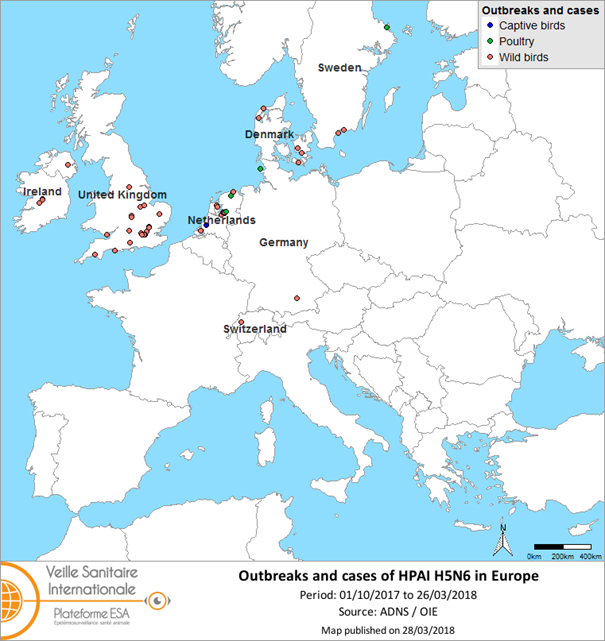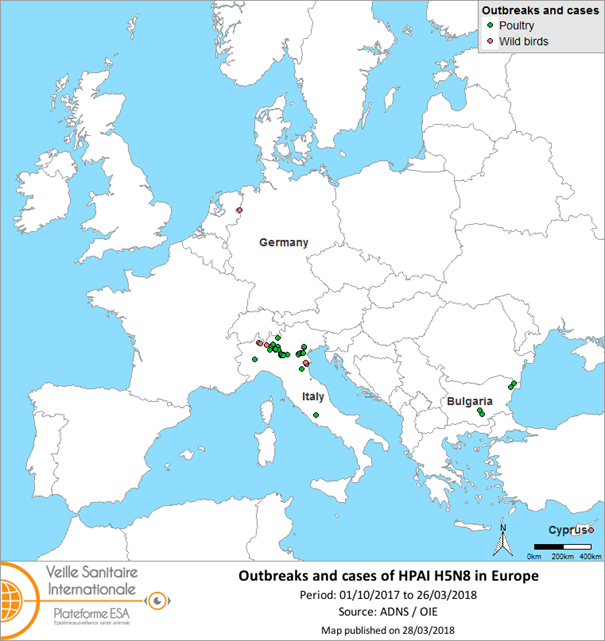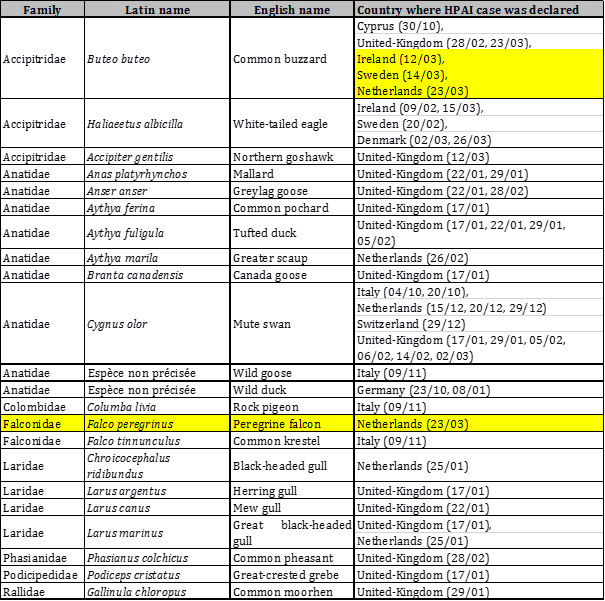Epidemiological situation of HPAI viruses from clade 2.3.4.4 in Europe as of 26th March 2018
For the Epidemic Intelligence team (VSI) (in alphabetical order): Anne Bronner (DGAL), Didier Calavas (Anses), Julien Cauchard (Anses), Sylvain Falala (Inra), Alizé Mercier (Cirad)
For the National Hunting and Wildlife Agency (ONCFS): Anne Van De Wiele
Corresponding author: alize.mercier@cirad.fr
Sources: Data updated on 26th March 2018 (included) ADNS/FAO/OIE, DGAL (General Directorate of Food – French Ministry of Agriculture), ProMED
Since the last situation report on 6th March 2018, the highly pathogenic avian influenza (HPAI) virus of subtype H5N6 has been identified in poultry farms:
- Germany: an outbreak in a duck, chicken, goose and turkey farm (notified 21st March),
- Sweden: an outbreak in a backyard farm including chicken, turkeys, pheasants, pigeons, quails and a goose (notified 16th March), and
- Netherlands: an outbreak in a poultry farm (species not mentioned) (notified 15th March).
The H5N6 virus was also detected in wild birds:
- Denmark: four white-tailed eagles (Haliaeetus albicilla) (four notifications on 26th March),
- Ireland: a common buzzard (Buteo buteo) (notified on 14th March) and a white-tailed eagle (notified on 13th March),
- Sweden: a common buzzard (notified on 14th March),
- Netherlands: a common buzzard and a peregrine falcon (Falco peregrinus) (two notifications on 23rd March), and
- United Kingdom: a common buzzard (notified on 23rd March).
The H5N8 virus continues to circulate in Europe with three outbreaks reported in Italy on 5th, 9th and 13th March in two laying-hen farms and a fattening turkey farm.
From 1st October 2017 to 26th March 2018 (included), a total of 104 outbreaks of HPAI H5 (including 56 outbreaks of H5N8) were notified in ten European countries: Bulgaria, Cyprus, Denmark, Germany, Ireland, Italy, the Netherlands, Sweden, Switzerland, and the United-Kingdom (Table 1, Figures 1&2). Two serotypes were identified: H5N8 (Figure 1) and H5N6 (Figure 2).
Figure 1: Map of HPAI H5N6 outbreaks and cases notified in Europe from 1st October 2017 to 26th March 2018 included (sources: ADNS/OIE)
Figure 2: Map of HPAI H5N8 outbreaks and cases notified in Europe from 1st October 2017 to 26th March 2018 included (sources: ADNS/OIE)
Table 1: Number of outbreaks in domestic, wild and captive birds notified in Europe from 1st October 2017 to 26th March 2018 by serotype and type of species (source: ADNS/OIE)
Several wildlife species and sectors of the poultry industry affected since 1st October 2017
The HPAI H5 outbreaks has affected several sectors of the poultry industry, including fattening turkeys, ducks, geese, laying hens and chickens, in both commercial and backyard farms.
Table 2 lists the affected wild bird species.
Table 2: List of wild bird species affected by HPAI in Europe from 1st October 2017 to 26th March 2017 (source: ADNS) (in yellow: new species/locations since the last update)
Many wild birds recently infected by IAHP H5 viruses are birds of prey, including the common buzzards (Buteo buteo). The majority of these buzzards are probably residents, which could indicate a diffuse infection from smaller birds which the buzzards prey on, an infection that could go unnoticed due to the small size of these preys (eg. sparrows).
The rock pigeon belongs to the Columbidae family, which is in general though to be less susceptible to avian influenza strains. The only cases of HPAI H5N8 detected in Columbidae in the world were located in the South-West of France (two common wood pigeons and five turtledoves), in direct link with the affected farms, with the hypothesis of a particularly high viral load developed in the affected poultry farms. This hypothesis is also valid for Italy. The list of wild species at risk in Europe has been published in the EFSA journal (Scientific opinion, adopté le 14 Septembre 2017, doi: 10.2903/j.efsa.2017.4991).
South-North migrations are currently ongoing.
A H5N2 virus detected in Russia
On 29th December 2017, Russia reported an outbreak of HPAI H5N2 in a poultry farm of more than 660 000 birds, in the region of Kostroma in the Northeast of Moscow (OIE report 29/12/2017). This outbreak was initially notified as H5N8 three days prior.
This is the first report of HPAI H5N2 virus in Russia and the last outbreak of HPAI H5N2 reported in Europe dates back to January 2017 with three outbreaks reported in poultry farms in France.
Regarding the origin of this virus, two hypotheses can be formulated:
- the mutation of a LP H5N2 virus in domestic birds, into a HP virus (as was the case in 2015 with H7N7 in the United Kingdom and Germany, or with H5N1 and H5N2 in France),
- a reassortment between HP H5N8 which circulated in Europe in 2016-2017 with a LP Eurasian strain, as for the H5N6 virus currently circulating in Europe. Indeed, viruses from clade 2.3.4.4 have a strong mutation potential, as illustrated by the emergence of H5N6 and H5N5 viruses following the circulation of H5N8 in Europe in 2016-2017.
Whatever the case may be, further analyses are needed to identify the origin, the link and the genetic composition of these new viruses, and the evolution of the epidemiological situation in Europe should be closely monitored.




